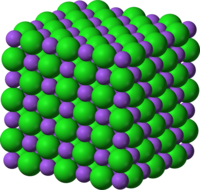
Photo from wikipedia
Abstract Two new occurrences of the lead oxy-sulfosalt chovanite have been identified at the Monte Arsiccio and Pollone mines, Apuan Alps, Tuscany, Italy. Chovanite from Monte Arsiccio occurs as black… Click to show full abstract
Abstract Two new occurrences of the lead oxy-sulfosalt chovanite have been identified at the Monte Arsiccio and Pollone mines, Apuan Alps, Tuscany, Italy. Chovanite from Monte Arsiccio occurs as black acicular crystals, up to 5 mm long, associated with rouxelite, robinsonite, sphalerite, valentinite, baryte, dolomite, quartz and Ba-rich K-feldspar (‘hyalophane’) inmetadolostone vugs. Its unit-cell parameters are a = 48.38(5), b = 4.11(4), c = 34.18(4) Å, β = 106.26(2)°, V = 6521(64) Å3, space group C2/m. Very weak reflections indicate the doubling of the b parameter. Electron-microprobe data gave (wt.%): Ag 0.28, Tl 1.51, Pb 45.57, Sb 31.00, As 1.09, S 19.73, Se 0.05, Cl 0.02, sum 99.25. On the basis of ΣMe = 58 apfu, its formula is Ag0.30Tl0.86Pb25.56Sb29.59As1.69S71.52Se0.07Cl0.05. Adding one oxygen atom, it is close to the formula TlPb26(Sb,As)31S72O. Chovanite from Pollone occurs as thick black acicular crystals, up to 1 cm long, associated with baryte and quartz. The high-diffraction quality of the available material allowed the solution and refinement of the 8 Å crystal structure in the space group P21/c, with unit-cell parameters a = 34.052(3), b = 8.2027(7), c = 48.078(4) Å, β = 106.258(4)°, V = 12891.9(19) Å3. The refinement converged to R1 = 9.14% on the basis of 19,853 observed reflections with Fo > 4σ(Fo). Electron-microprobe data gave (wt.%): Ag 0.12, Tl 0.54, Pb 48.34, Bi 0.20, Sb 26.71, As 3.37, S 20.23, Cl 0.07, sum 99.57. It corresponds to the formula Ag0.13Tl0.30Pb26.94Bi0.10Sb25.33As5.20S72.85Cl0.20, close to the idealized formula Pb28(Sb,As)30S72O, with a single oxygen atom bound to two (Sb/As) atoms alternating with a vacancy along b as in scainiite and in other Pb oxy-sulfosalts. The crystal chemistry of this 8 Å crystal structure is detailed, taking into account its modular description, the (Sb,As)mSn polymerization, its topological derivation from pellouxite, and the oxygen non-stoichiometry.
Journal Title: Mineralogical Magazine
Year Published: 2017
Link to full text (if available)
Share on Social Media: Sign Up to like & get
recommendations!